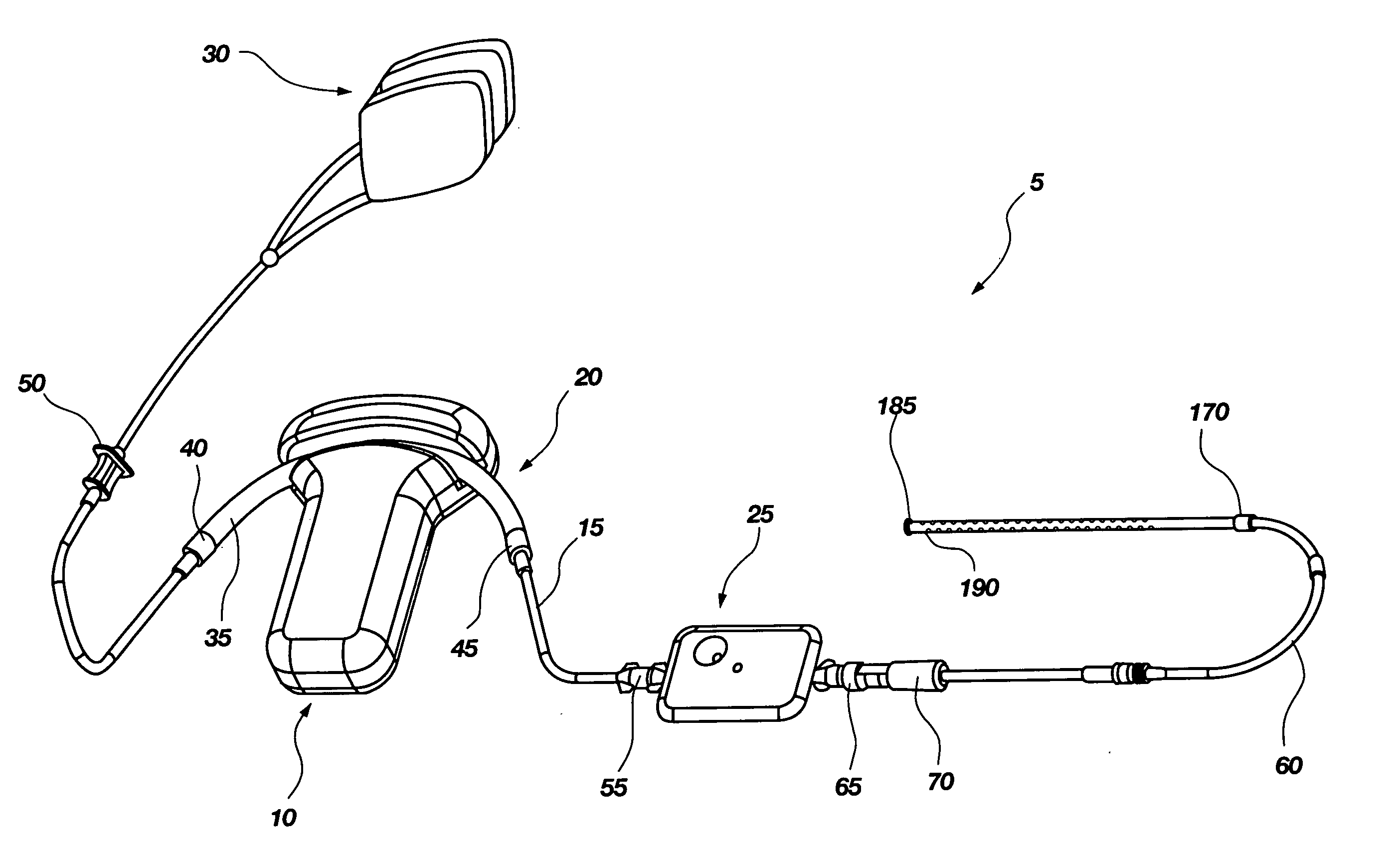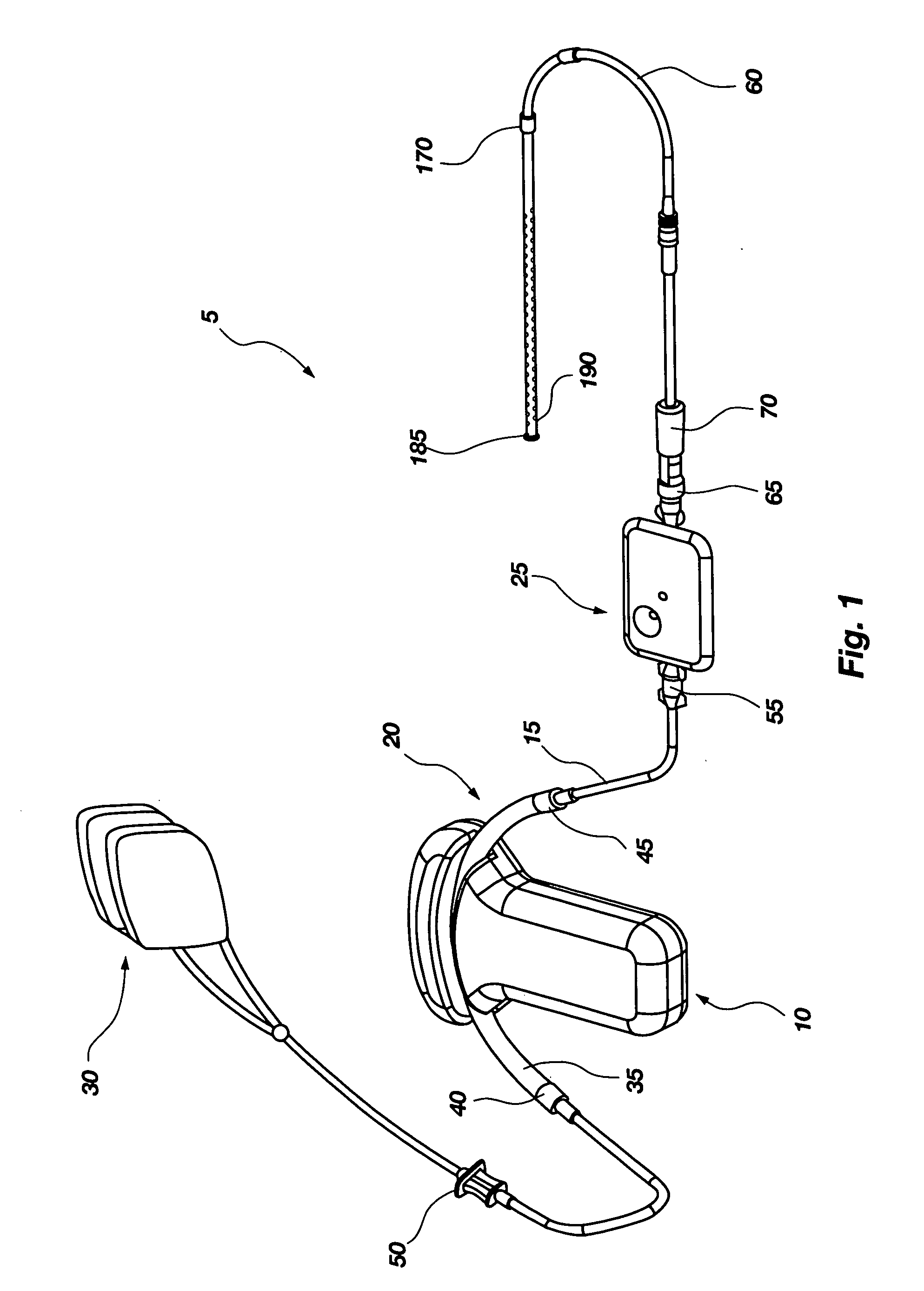[0017] This novel system enables coordination of fluid transfers and
dialysis processes with ambient physiological activity of the patient. Balance in physiological dynamics is enhanced with a more effective delivery and
monitoring system that follows natural rhythms. A system of indicators may communicate various therapeutic variables and physiological measurements, for example,
urea, presence of air, temperatures and electrolytes in the dialysate. Accordingly, the indicator system results in reduction of incidence of
peritonitis, potentially resulting in
cost savings and because it is more efficient in determining the parameters of the dialysate thereby improving timing and
fluid exchange. Such
fine tuning of physiological balances enhances the physician's and patient's ability to determine optimal dynamic dosage, regime and protocol for the benefit of the patient, irrespective of physical orientation of the patient or of the
treatment system or of both. The system entails a small portable pump,
filter system, receptacle, with improvements comprising a dialyzing fluid bag designed to be worn, which may alternatively simply be hung from an IV stand for
gravity flow where preferably, a novel
vest for low profile, aesthetically appealing, symmetric and unobtrusive system containment and placement, and indicators whereby fluid flow rates, volume, timing, direction, pulsating patterns and dialysate and bodily electrolytes,
urea,
protein, acid-base balances as examples may be monitored and regulated. The system comprising these improvements is inexpensive, disposable and sufficiently simple for use in a home care environment and may be equipped with a real-time monitor and indicator of various system conditions, dialysate parameters and other important therapeutic variables.
[0021] Indicator means may also be included whereby at least one therapeutic variable, but potentially any of a plurality of therapeutic or diagnostic variables, may be monitored or regulated to determine and establish optimal dynamic dosage or optimal dynamic regime or optimal dynamic protocol, or any or all of the foregoing. Such optimal dynamics enable achievement of a desired therapeutic balance. The indicator means may further enable detection of achievement of the desired therapeutic balance. Such therapeutic variables may be monitored or regulated selectively automatically or by direct intervention and may be monitored or regulated from a source remote from the patient. These therapeutic variables may comprise, alone or in combination, dialysate temperature or
dialysate flow volume or
dialysate flow direction or
dialysate flow timing or dialysate
chemistry including, for example, albumen,
urea,
uric acid,
creatinine,
creatine, pH, ions or electrolytes. The therapeutic variables may be monitored or regulated with detection structure positioned in any of a variety of locations including without limitation associated with the conduit or the pump or the receptacle system or any combination of the foregoing. The detection structure may be located proximal to or within the body of the patient and thus may further monitor and regulate the variables of body temperature or
residual pressure or blood content of the patient.
[0023] Accordingly, the present invention contemplates a method of performing peritoneal dialysis, comprising selection of the above characterized device system for treatment of renal decline or failure; association of said device system with an indwelling
dialysis catheter such that substantially all of an amount of exhausted dialysate within a peritoneum of a patient may be removed to be disposed of or processed for recycling; and infusion of a therapeutic volume of unused or recycled dialysate optimal for treatment of the patient.
[0024] In accordance with this method a selected volume of unused dialysate, which is in excess of the therapeutic volume and is sufficient to accomplish dialysis through an extended period of time during which the patient may be in a sleeping condition, may selectively be introduced to the peritoneum of the patient. This method may incorporate the distention-limiting structure within or around the receptacle system, may accommodate simultaneous or sequential passage or reciprocal circulation of exhausted and unused or recycled dialysate, either of which may be in a pulsating flow pattern, and may involve having the exhausted dialysate undergo a process that extends its useful life such as, alone or in combination,
filtration or chemical, electrical, thermal or light modification.
 Login to View More
Login to View More  Login to View More
Login to View More 


